Superfood, super delicious

Spring 2024 California Bountiful magazine

Exotic mulberries spread their roots in California
Story by Cyndee Fontana-Ott
Photos by Paige Green
The owners of a Bay Area mulberry farm thought they might attract a few hundred people on their first-ever U-pick weekend.
Instead, Habitera Farms drew more than a thousand. By the end of last year’s seven-week season, 35,000 mulberry fans had flooded into the Brentwood farm to pick, sample and take home boxes of the exotic, sweet berries clustered on slender stalks.
“I had never heard of a mulberry let alone had one,” says Andrina Spearman, who visited in June 2023 with her mother and 3-year-old grandson. “They were very tasty.”
“The best berries I have ever had in my life,” says Nasar Agboatwala, who picked with his wife, children and in-laws.
That turnout, coupled with intense interest at farmers markets, added up to a successful season for the agricultural operation known as Very Mulberry at Habitera Farms. More than 77,000 pounds of fruit were harvested in 2023, and that volume is expected to triple this year as trees continue to mature.
“It’s a berry that people absolutely fall in love with,” says Anil Godhwani, who partners with his brother Gautam and friend Smita Sadana in Habitera, which means “from the earth.”
“There are few things in life that just taste that good and are that good for you.”
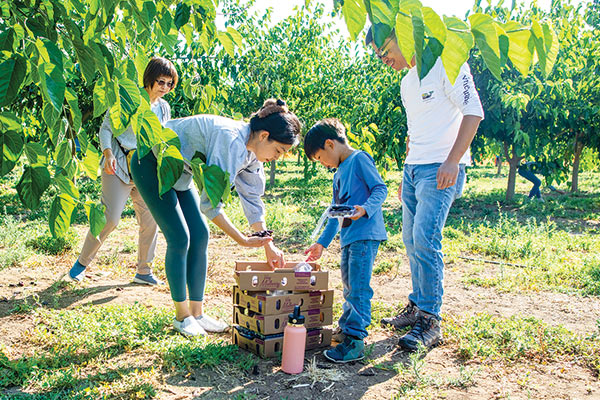
An uncommon berry
In California, mulberries are a specialty crop gaining in popularity, thanks partly to Habitera’s pesticide-free, large-scale commercial operation and other growers like Frog Hollow Farm, also in Brentwood. In addition, folks like restaurateur Anthony Roost and ice cream maker Ketki Dandekar are harnessing the fruit for seasonal use in food, drinks and desserts in the greater Bay Area.
Known for a firm texture and dozens of varieties, mulberries are more common in countries like India, Pakistan and China. The tightly clustered, juicy berries appear in many colors—ranging from dark purple to shades of white—and grow on trees that can easily reach 50 to more than 60 feet.
Frog Hollow has tended 5 acres of Pakistan mulberries for about eight years. The certified organic farm is home to thousands of trees ranging from cherries and pears to Meyer lemons and plums.
“Mulberries bring a high-value, unique and delicious fruit to our orchard in the spring,” says owner Rebecca Courchesne.
Frog Hollow sells at local farmers markets and to limited wholesale customers and community-supported agriculture, or CSA, members who receive fruit by subscription. It also supplies local restaurants with fresh mulberries in season and frozen berries in the off-season.
“Like cherries, mulberries are a highly anticipated crop by consumers,” Courchesne says. “They are the first to go in most cases and usually sell out in the first hour at farmers markets. I would emphatically say they are a very popular fruit, fresh or frozen.”
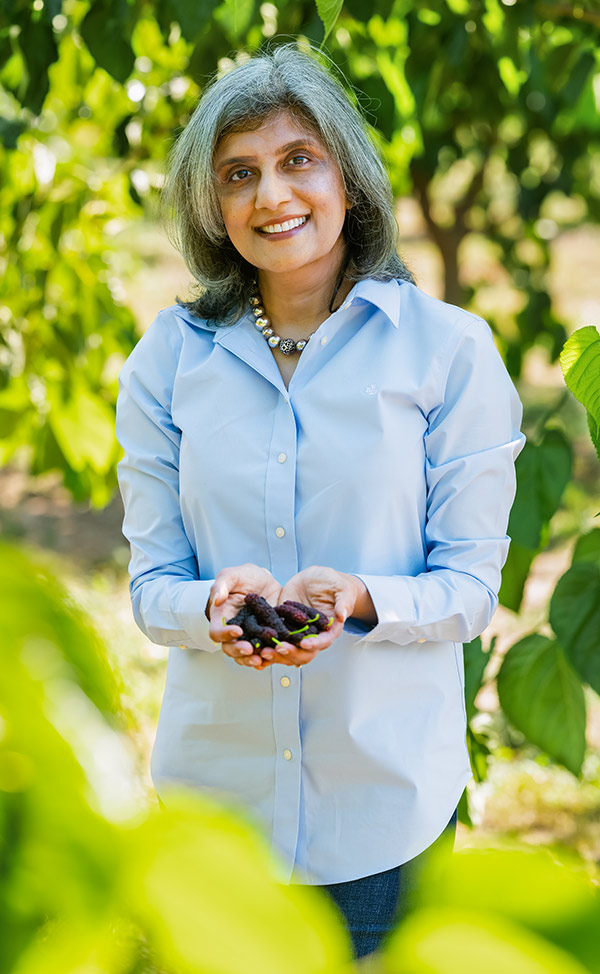
More than tasty
Flavor isn’t the only draw for mulberries, described as “the king of fruits” in a Persian proverb. They are considered a superfood due to healthy punches of fiber, vitamin C, iron and calcium, for example. “As a fruit independently, mulberry is really a nutritional powerhouse,” Sadana says.
Historically, however, mulberries haven’t been too common in California agriculture. Godhwani points to partly a lack of awareness, the long lead time to a meaningful harvest, the complexity in choosing a variety and the delicacy of the crop.
“They are the most fragile of berries,” he says, noting the typical after-harvest shelf life of less than a week. “Those are significant challenges for farmers to overcome.”
Habitera embraced the challenge. Both Sadana, who works in finance, and Godhwani have vivid memories of eating mulberries while growing up in India.
As a boy in Delhi, Godhwani threw rocks at his neighbor’s tree to harvest the fruit. “I couldn’t forget that taste when I moved to the United States,” he says. “I missed them.”
Godhwani built a career in sales and technology but always thought farming was in his future. “Ever since I was a kid in Delhi, my dad would take me to the local version of the farmers market called ‘subzi mandi,’ and I fell in love with that,” he says.
In the U.S., he and his father continued that tradition—sometimes visiting four or more stores and farmers markets to find just the right piece of produce. Eventually, Godhwani decided to plant a Himalayan mulberry tree in his backyard.
“I just happened to hit the jackpot because the tree turned out to be remarkable,” he says. He added a few more and, as that “mother tree” and others matured, Godhwani invited over friends and neighbors like Sadana to sample and enjoy the fruit.
“They were either missing it or they were trying it for the first time,” he says. “Each year I would start getting calls in April or May, saying, ‘Are they here yet?’ I realized that people don’t really do that unless they really love something.”
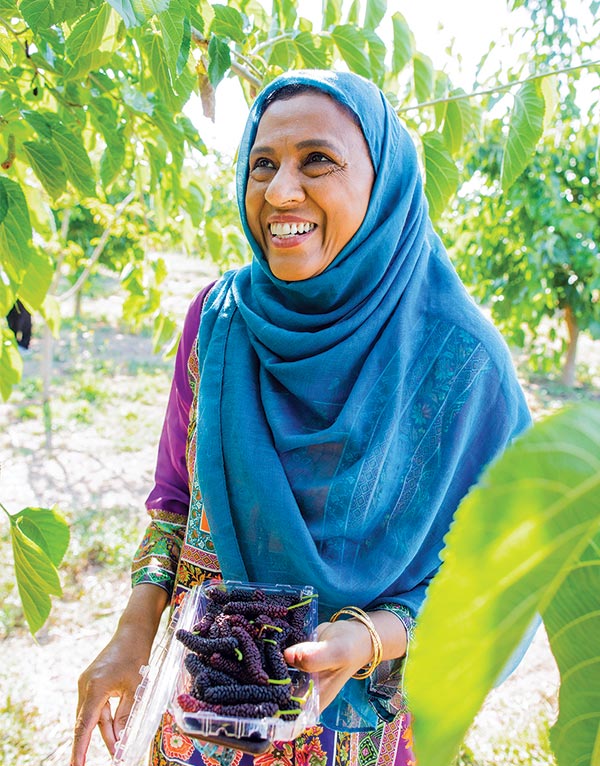
A mulberry farm takes root
In 2018, Godhwani started the farm after purchasing about 90 acres in Brentwood. His brother and Sadana joined him, and the first set of trees was planted in 2020. Additional trees rolled out over the years, and that first tree in Godhwani’s backyard provided more than just inspiration.
“The DNA from that tree is remarkable,” Sadana says. “Most of our trees in the year 2020 came from that one, and then after that we have done grafting from those trees.”
Today, Habitera Farms grows two varieties of Himalayan mulberries—white and purple, with the dark fruit occupying all but about 1 acre of the ground in production. Himalayan mulberries also are called Pakistan mulberries.
Mulberry is a fast-growing tree but takes three or four years to generate a substantive crop, Godhwani says. One tree can produce up to a few hundred pounds of mulberries each season, which typically runs from late spring through June in California.
At Habitera, trees are kept at a reasonable height for ease of harvest. The farm tried nearly a dozen picking and catching harvest practices before locking into the current system, which relies partly on a mobile cart loosely modeled after a “rehri” cart. In India, produce sellers push the rolling wooden carts through neighborhoods.
To harvest mulberries at Habitera, workers gently shake a limb or the tree to free the ripe fruit. Berries fall onto fine mesh nets attached to the carts.
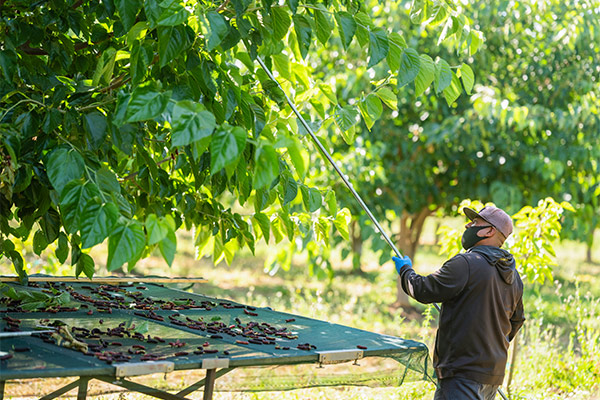
Picking for generations
In 2023, Habitera opened up for U-pick for the first time, inviting visitors to snag ripe berries from lower branches of trees. Brentwood, located in the East Bay of the greater Bay Area, has a tradition of U-pick and dozens of farms that participate every year.
Habitera visitors have ranged from toddlers to a 100-year-old great-grandmother who remembered climbing a mulberry tree in China in the 1930s. More than a few groups have spanned several generations—like Michelle Ho and her extended family.
“Our family usually just does blueberries but since the grandparents were here, we wanted to take them to pick something unique,” she says. The children “were very excited as well since there’s no other fruit picking like mulberries. ... We took home as many as we could.”
That’s just what Godhwani loves to hear. “Our goal is to introduce mulberries to America,” he says. “We think the market will grow not just in Silicon Valley and California, but all over the United States.”
Mulberries find a home on seasonal menus
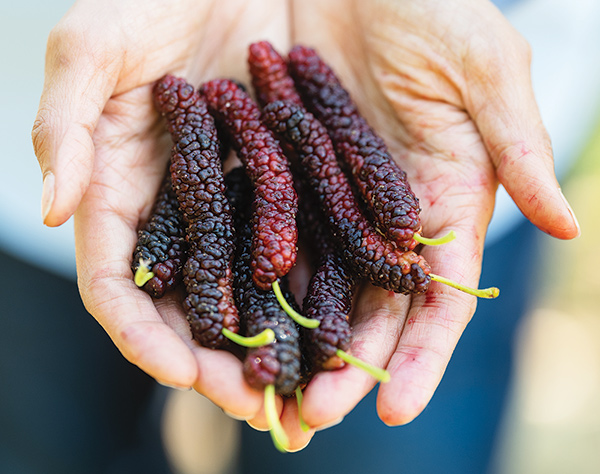
Bay Area restaurateur Anthony Roost believes part of his job is introducing new flavors and foods to his customers. So when mulberries began to debut at area farms, he started looking for ways to use them in entrees, cocktails, desserts and more.
“It’s an easy-on-the-palate flavor,” says Roost, who partners with his wife, Alyssa, in two wine bars and the Attraversiamo restaurant in Brentwood. “Not a lot of people know about them, and they are great to work with.”
As this unique fruit grows in fresh availability—and popularity—in California, many chefs, bakers and dessert makers are adding mulberries to their seasonal menu. Brentwood-area growers like Habitera Farms and Frog Hollow Farm help supply foodies and the greater food community, and Habitera also offers mulberry recipes on its website.
Ketki Dandekar, co-founder of Pints of Joy in Sunnyvale, says the shop tends to lean on Indian flavors in its artisanal offerings but also whips up more familiar ice creams like chocolate. She says many customers are looking for those traditional Indian flavors while others want to try something new.
Mulberries fit both categories. Dandekar, who was introduced to mulberries growing up in India, found that “it’s such a rare fruit here that a lot of the people didn’t know what the actual fruit tasted like.”
So last season, working with Habitera Farms, the shop offered samples and sales of the actual fruit along with mulberry ice cream. The cross-promotion worked, as both the fruit and ice creams were “very popular,” she says.
Roost’s customers were treated to such seasonal offerings as a mulberry panna cotta and a skirt steak over lentils with mulberry sauce. The Mulberry Smash, the “cocktail of the month” in season, was a hit, he says. “People loved it.”

